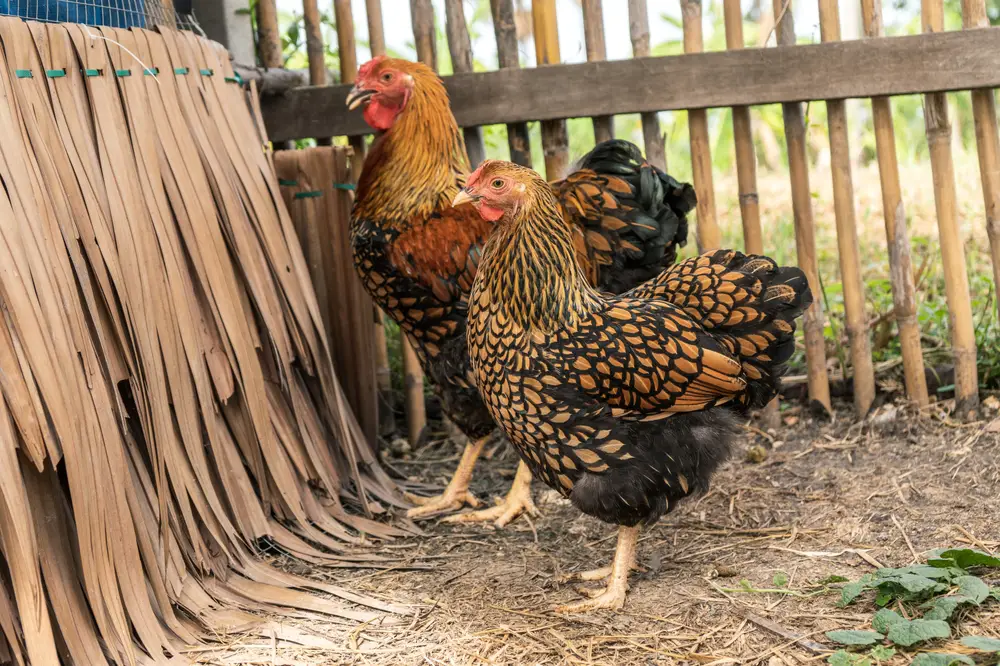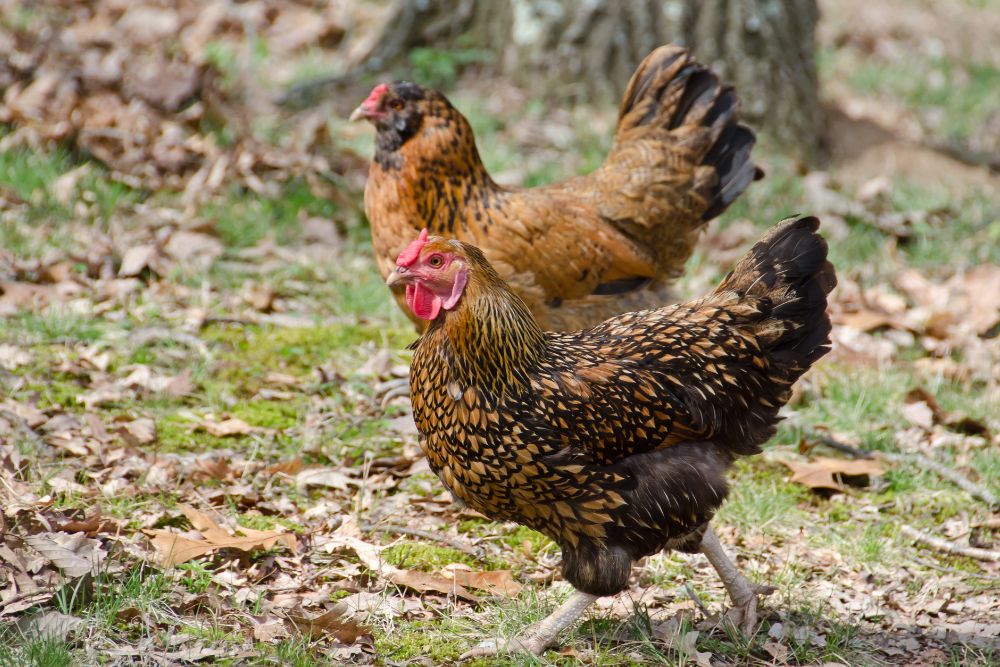Golden Wyandotte chickens are great egg-layers and lay light brown eggs. You can expect around 4 large eggs per week, even during the winter months with the mothers making great mothers for their young chicks.
Read on to discover if this breed will make the perfect addition to your backyard chicken coop.
Table of Contents
Golden Wyandotte Background
A great utility bird as well as a beauty, the Golden Laced Wyandotte chicken has the distinction of being among the first chickens developed to be dual-purpose alongside Rhode Island Reds in the 1800s.
They are an American chicken breed that is a cross between a Silver Laced Wyandotte and a Winnebago (game fowl).
The Silver Laced Wyandotte was first bred by crossing a Hamburg and Cochin and had such a distinctive appearance that breeders continued developing additional varieties of the Wyandotte breed. The second Wyandotte developed was the Golden Laced Wyandotte.
They are beautiful birds to look at and the American Poultry Association accepts the following standard colors: both silver and gold laced, black, partridge, blue, Columbian and silver penciled.
The blue laced and white are not yet accepted by the APA but are accepted in the U.K.
Backyard flock owners who are interested in Wyandotte chickens will have a hard time choosing their favorite, but most people tend to prefer Golden Laced Wyandottes and Silver Laced Wyandottes.
Golden Wyandotte Chicken Breed Overview
| Recognized Breed Name | Golden Laced Wyandotte |
| Lifespan | 6 years |
| Coloring and Pattern | Gold color feathers with black lacing. Red earlobes and wattles. |
| Weight | 6.5lbs to 8.5lbs for standard and 24 to 30 ounces for bantam version. |
| Comb Type | Rose comb |
| Distinctive Details | Beautiful lacing pattern on feathers |
| Feather Type | Standard – tend to be dense and held tight to the body |
| Heritage Breed | Yes |
| Tolerant to Heat? | Yes |
| Tolerant to Cold? | Yes |
| Meat Production Breed? | Yes |
| Egg Production Breed? | Yes |
| Lays in Winter? | Yes |
| Egg Size | Large |
| Egg Color | Light Brown |
| Egg Production | 200/Year |

Egg Production
Golden Laced Wyandottes are good egg layers and will even continue egg laying in the winter months because they do well in cold climates. Wyandotte hens tend to be broody and make excellent mothers to their baby chicks.
Temperament
These beautiful chickens have strong personalities and are usually found at the top of the pecking order. They are noisy and boisterous, so may not do well in urban settings with close neighbors.
They tend do be docile and bonded to their chicken keepers, and may be friendly with people they know. While they are tolerant of children, they are certainly not lap chickens.
They prefer to be around their own kind and don’t do well in mixed flocks.
Golden Wyandotte Chicken Coop
Gold Laced Wyandotte chickens can handle confinement in a chicken coop but they also like to forage, so giving them access to free-range is a benefit for this backyard chicken.
They require roughly 15 square feet per chicken, the same as most other chicken breeds. Laying hens will need nesting boxes to sit on their eggs that are at least 12×12.
These chickens also require multiple perches and places to roost in order to avoid parasites that are on the ground, the same as other breeds. Luckily, Wyandottes do not have any other health problems.
While Wyandotte chicks are usually well looked after by their mothers, having an incubator set up for unattended eggs is a good idea, particularly in cold months.
Baby chicks will need a heated brooder after they are born with a feeding and watering area. It’s best to keep Wyandotte chicks separated from the rest of your adult flock until they are older and are ready to go outside.
While Wyandotte hens and pullets are most often used for egg production, cockerels and roosters are often treated as broilers in this dual-purpose breed.
Food and Health
The feed requirements will vary depending on the age and sex of your chickens.
Baby chicks should be given chick starter which is usually given as a crumble or mash.
Once a Wyandotte chick reaches 6 weeks old, they will require grower feed to develop into a cockerel or pullet. Grower feed is specifically developed to help them grow quickly which is important in this slow growing American breed.
Wyandotte hens at the point of lay should be given layer feed that has 16% to 18% protein. They should be given oyster shell to help supplement their calcium intake so they continue to produce strong eggshells.
Wyandotte roosters can eat the same layer feed but should not be given oyster shell. Both hens and roosters should have unrestricted access to chicken grit alongside their food after they are 6 weeks old to help their digestive system.
Wyandotte chickens also enjoy table scraps of fresh fruits and veggies from time to time. Ensure that anything you choose to give them is safe for chickens, and never give them these treats in lieu of their chicken feed.
FAQs
How much do Golden Laced Wyandottes Cost?
Golden Laced Wyandotte chicks costs vary depending on the breeder but generally in a straight run they cost between $6 and $8 each, not including shipping. A pullet that’s ready to start laying may cost you more than $100.
Are Golden Laced Wyandotte Chickens Friendly?
Golden Laced Wyandotte chickens are friendly with their keepers and people that they know well, but may not be friendly towards strangers.
What Other Chicken Breeds Can You Cross with Golden Laced Wyandottes?
Golden Laced Wyandottes generally do not like to be around chickens that aren’t of the same breed. They don’t take well to newcomers being added to the flock either.
Your best bet for breeding would be other Wyandotte breeds such as the Silver Laced Wyandotte.
What Color is a Golden Laced Wyandotte?
Golden Laced Wyandottes have golden feathers that are each outlined in deep black. They have bright red rose combs, wattles and earlobes and they are among the most beautiful chickens in the world.

